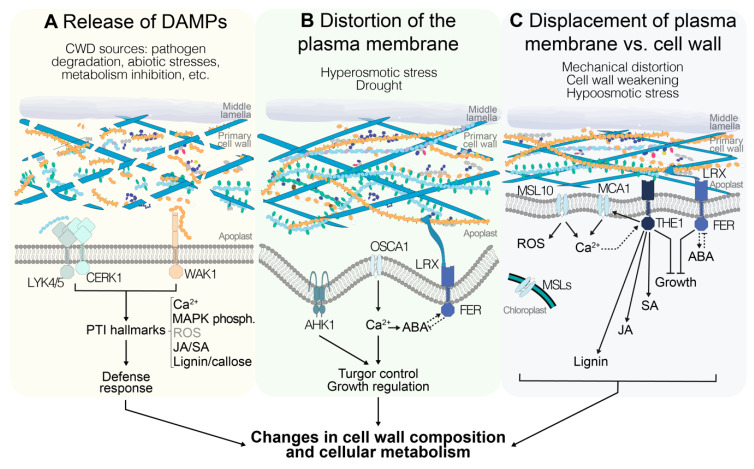Figure 2.
Different stimuli could indicate alterations in cell wall integrity (CWI) in Arabidopsis thaliana, and are perceived through different signaling pathways. (A) Release of cell wall fragments, also known as damage-associated molecular patterns (DAMPs), is interpreted by the plant as the result of cell wall damage (CWD) that can derive from biotic and abiotic stresses as well as endogenous processes. DAMP perception by pattern-recognition receptors activates typical immunity responses including increases in cytoplasmic [Ca2+], phosphorylation of mitogen-activated protein kinases (MAPKs), production of jasmonic acid(JA)/salicylic acid (SA), reactive oxygen species (ROS), and lignin, and callose deposition. (B) Distortion of the cell wall–plasma membrane continuum occurs in response to plasma membrane shrinkage during hyperosmotic stress (drought). Mechanosensitive ion channels mediate Ca2+ influx into the cytoplasm, leading to the activation of signal transduction pathways. Moreover, interactions between abscisic acid (ABA) and FER modulate growth in response to the state of turgor pressure. (C) If the plasma membrane is stretched, either by a weakened cell wall or as result of hypoosmotic stress, mechanosensitive ion channels are activated and [Ca2+] in the cytoplasm is increased. Several of these channels are also required for the production of ROS. Moreover, THE1-mediated signaling modulates CWD-induced lignin and JA/SA production, and together with FER leads to growth arrest until CWI is recovered. The pathways in A, B, and C eventually lead to a series of changes in cell wall composition and cellular metabolism, enabling the plant to maintain CWI in response to different challenges.

